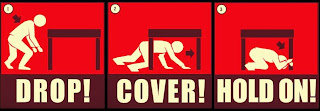Our Geol9 class is exploring
the volcanic hazards in different countries and their warning systems. I’ll be
focusing on the US.
There are several ways we
minimize the danger of volcanic activity (apart from the obvious of ‘getting
out of the way’…(J:
·
Forecasting (earthquakes as early warnings -although in 2014 a Japanese
volcano erupted without any previous seismicity (livescience
article), land swelling before eruption, gas emissions, etc.)
·
Volcanic Alert Codes (USGS): the levels of alert and the aviation
code levels commonly change at the same time (chart on right). A non-erupting
volcano will have a green icon, and a red one indicates an imminent eruption
(see USGS Alert
Codes).
Today the US hazards map [below] shows 4
volcanoes as to be above normal background (elevated unrest):
Veniaminof,
Kilauea, and Great Sitkin Alert Level=ADVISORY. Aviation Color Code=Yellow.
and Cleveland Alert Level=WATCH.
Aviation Color Code=Orange.




